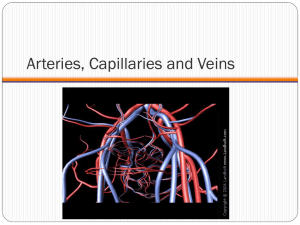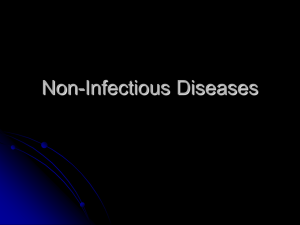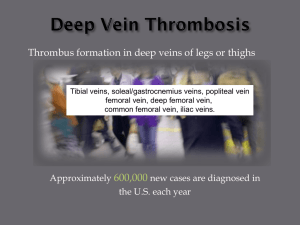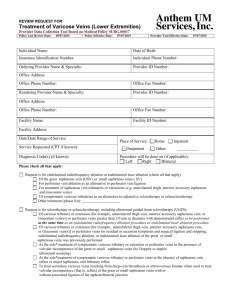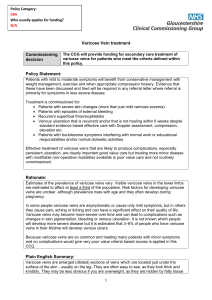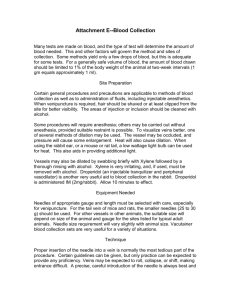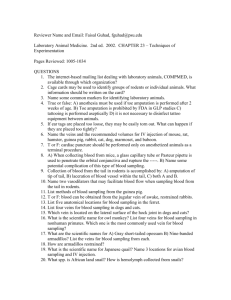Clarivein® treatment for varicose veins
advertisement
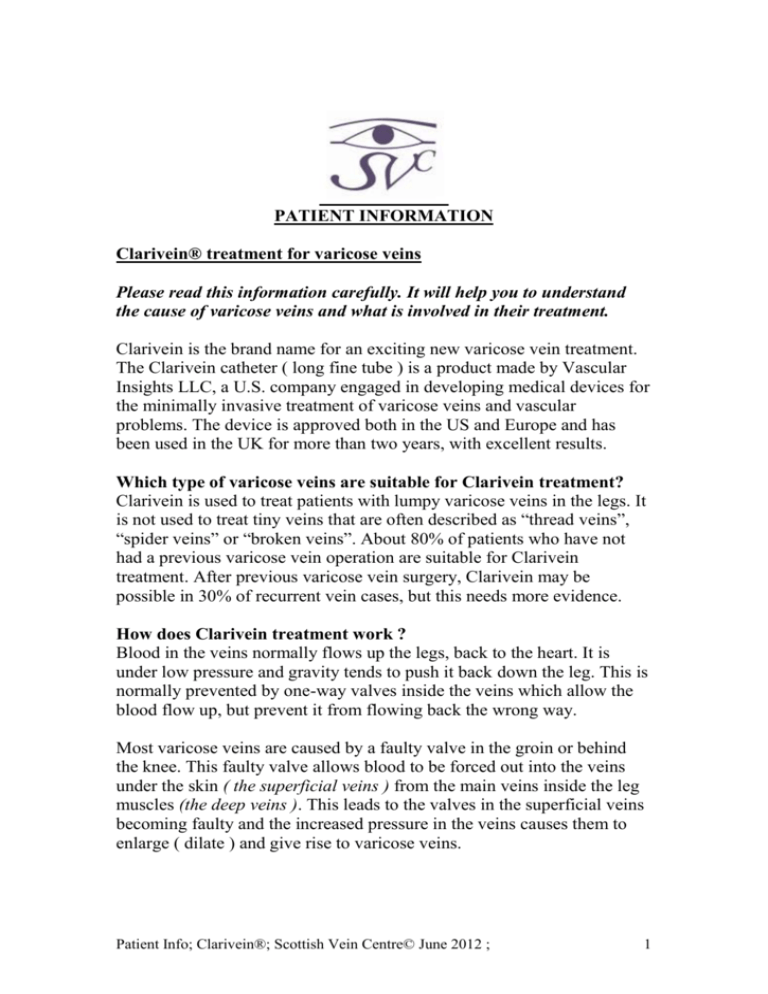
PATIENT INFORMATION Clarivein® treatment for varicose veins Please read this information carefully. It will help you to understand the cause of varicose veins and what is involved in their treatment. Clarivein is the brand name for an exciting new varicose vein treatment. The Clarivein catheter ( long fine tube ) is a product made by Vascular Insights LLC, a U.S. company engaged in developing medical devices for the minimally invasive treatment of varicose veins and vascular problems. The device is approved both in the US and Europe and has been used in the UK for more than two years, with excellent results. Which type of varicose veins are suitable for Clarivein treatment? Clarivein is used to treat patients with lumpy varicose veins in the legs. It is not used to treat tiny veins that are often described as “thread veins”, “spider veins” or “broken veins”. About 80% of patients who have not had a previous varicose vein operation are suitable for Clarivein treatment. After previous varicose vein surgery, Clarivein may be possible in 30% of recurrent vein cases, but this needs more evidence. How does Clarivein treatment work ? Blood in the veins normally flows up the legs, back to the heart. It is under low pressure and gravity tends to push it back down the leg. This is normally prevented by one-way valves inside the veins which allow the blood flow up, but prevent it from flowing back the wrong way. Most varicose veins are caused by a faulty valve in the groin or behind the knee. This faulty valve allows blood to be forced out into the veins under the skin ( the superficial veins ) from the main veins inside the leg muscles (the deep veins ). This leads to the valves in the superficial veins becoming faulty and the increased pressure in the veins causes them to enlarge ( dilate ) and give rise to varicose veins. Patient Info; Clarivein®; Scottish Vein Centre© June 2012 ; 1 The principle behind Clarivein is the complete closure of the faulty varicose vein using a combination of a rapidly rotating catheter tip inside the affected vein combined with direct application of an irritant chemical via the catheter into the damaged abraded vein wall. This blocks all blood flow in that vein and stops the faulty valve in the groin or behind the knee having any effect. It achieves the equivalent of conventional surgery when a wound is made in the groin or behind the knee to put a ligature around the top of the vein which is then removed by stripping. Clarivein is therefore used to treat the underlying cause of your varicose veins. How can we tell if your varicose veins are suitable for Clarivein? You will be asked a series of questions about any symptoms that your varicose veins are causing and any other health problems that you may have had. We will examine your legs and perform an ultrasound, called Doppler ultrasound. This is a form of scan that can check blood flow and direction. It will identify which faulty valves have caused your varicose veins. Scanning is done in a standing position and takes about 10 minutes per leg. It is done at an initial assessment, and is also repeated at the time of Clarivein treatment. If the main faulty vein valve is in the groin or behind the knee, your varicose veins should be suitable for Clarivein. We do not treat people during pregnancy, and will also take account of other medical conditions. What does Clarivein treatment involve ? The procedure begins with an ultrasound scan in the standing position to mark the vein in your leg to be treated. With the patient lying an injection of local anaesthetic is given to freeze the skin only at the point of entry of the Clarivein catheter. A small nick in the skin allows the easy passage of an outer skinny tube into the vein ( micro-puncture sheath ), done with ultrasound guidance, and directed upwards from above or below the knee. The Clarivein catheter is then passed via the sheath and threaded along the length of the affected vein to just below the groin. A very fine wire is then pushed forward out of the Clarivein catheter and placed 2cm below the top of the varicose vein. The position is double-checked with ultrasound scanning. The Clarivein rotating hand-held motor is switched on for 2 seconds to prepare the patient and tighten up the vein. Now the vein specialist simultaneously runs the motor while slowly injecting a chemical sclerosant solution and gradually pulling back the whole device towards the entry point. Patient Info; Clarivein®; Scottish Vein Centre© June 2012 ; 2 The catheter delivery system is withdrawn at a rate of 1 – 2mm per second, or 1cm every 10seconds. This means an average 30cm vein length will take 5 minutes to completely close. When the vein has been sealed up, the Clarivein catheter is removed via the small puncture. No stitch is needed. Compression bandaging is applied to the treated segment, usually crossing the knee. This is worn for 48 hours continuously. A graduated compression stocking is applied to the leg over the bandages. You should keep this on for 2 days and nights, then during the day for 10 further days. What happens after the treatment? After Clarivein treatment you will be asked to walk around for 5 minutes, have a drink, and relax for a short while, before going home. You should not drive yourself and exercise for 5 minutes every hour, during the first 2 days. During the first few days you may feel some discomfort or tightness over the treated vein. To minimise this we recommend you take an anti-inflammatory drug, such as Nurofen, which contains ibuprofen. This is also a good painkiller. The adult dose is 400mg ( either 1 or 2 tablets depending on type, please check packet ) to be taken 8 hourly up to a maximum dose of 1200mg in any 24 hour period. We recommend that you take this for up to 3 days, as required. If you have a history of stomach ulcers, we advise you try paracetamol instead. If any discomfort remains after 3 days you can take paracetamol. The adult dose of paracetamol is 500mg (1 tablet ) or 1000mg ( 2 tablets )every 4 to 6 hours up to a maximum of 4000mg (8 tablets) in 24 hours. Always read the package instructions carefully. Normal activity, including work, can be resumed as soon as you like, although we suggest avoiding contact sports, the gym and swimming for a few days after Clarivein® vein treatment. The compression stocking is specially measured to fit. If it is uncomfortable please contact us for advice. It can be rolled down for skin cleaning or changed ( one pair supplied per leg ) and washed. But it must be worn 24 hours per day during the first 48 hours and during the day for at least 10 days. We will arrange to see you about 4-6 weeks after the procedure. By then most of your varicose veins will have shrunk and many may have disappeared. If some remain these can be treated by injection. This is an outpatient treatment that we use to treat less Patient Info; Clarivein®; Scottish Vein Centre© June 2012 ; 3 severe and left-over varicose veins. The injection treatment replaces the multiple small wounds that are made in the leg to remove the lumpy veins during surgery. What are the advantages of Clarivein® vein treatment over surgery? It is performed under local anaesthetic. The procedure is done as an outpatient, taking 45 minutes total. You should be able to resume your normal activities straight away and return to work the next day. It avoids the incisions (scars) required for a standard operation and therefore avoids complications such as wound infection. There is no risk of nerve damage. Patches of numbness on the skin occur in 5% of patients having conventional surgery There is very little discomfort after the procedure. Evidence is now fairly conclusive that EVLA laser treatment will give better results than surgery at 3 and 5 years. The follow-up results of Clarivein compare favourably to those of laser at twelve months, and look promising in cases seen at up to 2 years. Clarivein can be used in any incompetent varicose vein suitable for EVLA laser treatment and RFA VNUS Closure treatment. It does not require the multiple uncomfortable local anaesthetic injections normally applied along the length of the treated vein for EVLA and RFA. ( tumescent anaesthesia ) There is therefore noticeably less bruising with Clarivein. Are there any complications from Clarivein treatment? Complications following Clarivein are uncommon. Those of which you should be aware of are : Failure to obliterate the vein being treated. This occurred in only one of the first cases in a published series of 30 cases. Minor thigh bruising is seen in about 10% of patients. If it occurs, it may be helpful to take anti-inflammatory drugs. No cases of nerve injury have been reported yet ( 1% of patients may experience some numbness in the lower leg after EVLA ) No cases of deep vein thrombosis ( DVT ) have been reported. Emergency contact number For any post-operative problem directly related to your treatment you may call the SVC number on: 0131 477 4775 We will have a trained member of staff to deal with your query. We also advise that for any non-urgent queries you first consult your own GP. Patient Info; Clarivein®; Scottish Vein Centre© June 2012 ; 4
